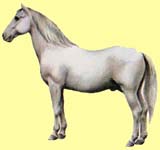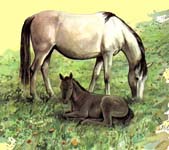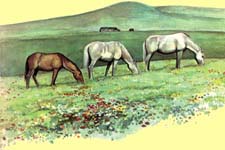|
|
Lipizzan |
|
|
|
Lipizzan |
|
 The Lipizzaner is famous around the world because it is the breed used by the Spanish Riding School of Vienna, the foremost exponent of the art of hauté ecol, of High School riding. Is it bred all over what was once the Austro-Hungarian Empire. The School horses are raised at Austria's Piber Stud near Graz, but state studs in Hungary, Romania, Czechoslovakia and Yugoslavia also specialize in the breed. It takes its name from Lipizza (Lipica), now in Yugoslavia, but was then Austria when it was founded in 1850 by Archduke Charles II.
The Lipizzaner is famous around the world because it is the breed used by the Spanish Riding School of Vienna, the foremost exponent of the art of hauté ecol, of High School riding. Is it bred all over what was once the Austro-Hungarian Empire. The School horses are raised at Austria's Piber Stud near Graz, but state studs in Hungary, Romania, Czechoslovakia and Yugoslavia also specialize in the breed. It takes its name from Lipizza (Lipica), now in Yugoslavia, but was then Austria when it was founded in 1850 by Archduke Charles II.
The Archduke imported nine Spanish stallions and twenty-four mares from the Iberian Peninsula to ensure the supply of suitable grand horses to the ducal stables at Graz and the court stables in Vienna. From these horses, plus occasional outcrosses, several strains developed, and these were the foundation stock upon which the Lipizzan breed was based. The five principal stallions were: Pluto1 (about 1765), a pure white Spanish horse; Conversano (about 1767), a black Neapolitan, and Neapolitano, a bay; Favory (about 1179), a dun Kladruber from Bohemia; Siglavy (about 1810), a white Arab; and Maestoso (about 1819) a Spanish/Neapolitan cross. Descendants of these stallion lines are still maintained at the Spanish Riding School, and 14 or the original 24 mare lines are preserved at Piber.
Today, the Lipizzans used in the Spanish Riding School are bred at Piber. At six months old, the foals are branded with a "P" and the Austrian crown together with an "L" for Lipizzaner, and the initial of the sire's lineage, "P" for Pluto, "C" for Conversano, etc.
 All foals are born
black or
dark brown, occasionally a
bay occurs. Most of them change to
white as they mature. They are slow to mature, but are notably long-lived. Many of the Spanish School stallions are working at well over 20 years of age. Standing anywhere from 15 hands (Piber Lipizzaner) to 16.2 hands (Hungarian type, with
Thoroughbred influence). They are very compact and strong with short, powerful limbs, flat joints, short cannons, good bone and hard hooves; although not built for speed, he is ideally suited to the school disciplines because of his powerful quarters. His withers are often less pronounced and the shoulder matches this formation, which is suited for harness as much as riding. The action is high, agile and athletic. He has a quiet temperament.
All foals are born
black or
dark brown, occasionally a
bay occurs. Most of them change to
white as they mature. They are slow to mature, but are notably long-lived. Many of the Spanish School stallions are working at well over 20 years of age. Standing anywhere from 15 hands (Piber Lipizzaner) to 16.2 hands (Hungarian type, with
Thoroughbred influence). They are very compact and strong with short, powerful limbs, flat joints, short cannons, good bone and hard hooves; although not built for speed, he is ideally suited to the school disciplines because of his powerful quarters. His withers are often less pronounced and the shoulder matches this formation, which is suited for harness as much as riding. The action is high, agile and athletic. He has a quiet temperament.
The Spanish Riding School and the Piber herd owe their survival to American troops who rescued them from advancing Russians at the end of World War II.
The Lipizzan horse of Austria is known as a winged Pegasus, flying where no other horses fly, performing movement above the ground that no other horse has accomplished through training. It is royalty, irreproachable, and one of the most beautiful performing horses in the world.
1 Pluto is said to have been a Frederiksborg, of Spanish descent, imported from Denmark.
Look for an update on this article.
 For more information on Lipizzans, visit:
For more information on Lipizzans, visit:

|
© 1997-2007
NW Breyer Horse Club & Refiner of Gold Creations Equinealities in place since 1997, Section in place 2001, Updated 3/13/2007 |



|
| ||

|
|||||